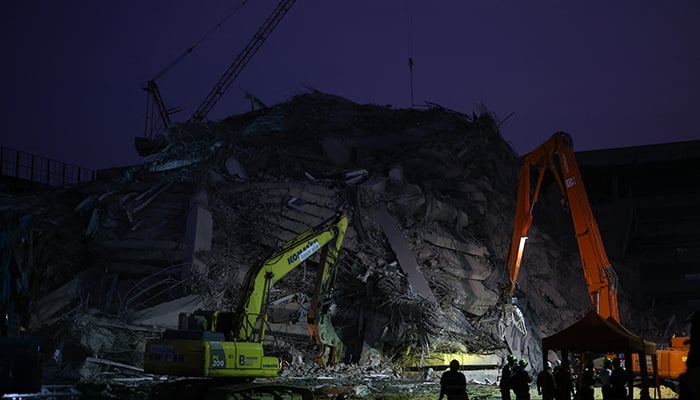Exhausted and overwhelmed rescuers in Myanmar’s second-largest city pleaded for help on Saturday as they struggled to free hundreds of people trapped in buildings destroyed by a devastating earthquake.
Friday’s shallow 7.7-magnitude quake demolished dozens of buildings in Mandalay, the country’s cultural capital and home to over 1.7 million residents.
On one street, a monastery’s clock tower lay collapsed on its side, its hands frozen at 12:55 pm — just minutes after the quake struck.
Among the worst-hit structures in the city is the Sky Villa Condominium development, where more than 90 people are feared trapped.
The quake reduced the building’s 12 stories to six, with the cracked pastel green walls of the upper floors perched precariously on the crushed remains of the lower levels.
A woman’s body was visible in the wreckage, her arm and hair dangling down.
Rescuers painstakingly clambered over the ruins, removing pieces of rubble and wreckage by hand as they sought to create pathways to those trapped inside.
Scattered around the debris were remnants of people’s lives — a child’s plastic bunny toy, pieces of furniture, and a picture of the New York skyline.
After hours of grueling work, a rare moment of joy arrived as rescuers pulled Phyu Lay Khaing from the remains of the Sky Villa Condominium — alive after 30 hours beneath the rubble.
She was carried out on a stretcher to be embraced by her husband, Ye Aung, and taken to the hospital.
“In the beginning, I didn’t think she would be alive,” Ye Aung told AFP, as he anxiously awaited his wife’s emergence from the rubble.
“I am very happy that I heard good news,” said the trader, who shares two sons, eight-year-old William and five-year-old Ethan, with his wife.
‘More Help Is Needed’
Some residents sought shelter under the shade of nearby trees, where they had spent the night, their few salvaged possessions — blankets, motorbike helmets — beside them.
Elsewhere, rescuers in flip-flops and minimal protective gear sifted through the remnants of buildings, calling out into the rubble in hopes of hearing a survivor’s reply.
“There are many victims in condo apartments. More than 100 were pulled out last night,” one rescue worker, requesting anonymity, told AFP.
As darkness fell on Saturday, AFP journalists witnessed dozens of people preparing to sleep in the streets for a second night.
Widespread power outages have hampered rescue efforts, with emergency personnel relying on portable generators.
After more than 24 hours of desperate searching, many are exhausted and desperate for relief.
“We have been here since last night. We haven’t got any sleep. More help is needed here,” the rescue worker told AFP.
“We have enough manpower but we don’t have enough cars. We are transporting dead bodies using light trucks. About 10-20 bodies in one light truck.”
Myanmar is accustomed to regular earthquakes, bisected north to south by the active Sagaing Fault, but the violent force of Friday’s quake was exceptional.
More than 1,600 deaths and 3,400 injuries have already been confirmed, and as the scale of the disaster continues to unfold, the toll is likely to rise significantly.
“Yesterday, when the earthquake happened, I was in my home. It was quite scary,” Mandalay resident Ba Chit, 55, told AFP.
“My family members are safe, but other people were affected. I feel so sorry for them. I feel very sad to see this kind of situation.”
Myanmar’s ability to cope with the earthquake’s aftermath will be hindered by the effects of four years of civil war, which have devastated the country’s healthcare and emergency systems.
Indicating the potential magnitude of the crisis, the junta has issued an exceptionally rare call for international aid.
Previous military rulers have rejected all foreign assistance, even after major natural disasters.
“We need aid. We don’t have enough of anything,” resident Thar Aye, 68, told AFP.
“I feel so sad to see this tragic situation. I’ve never experienced anything like this before.”



